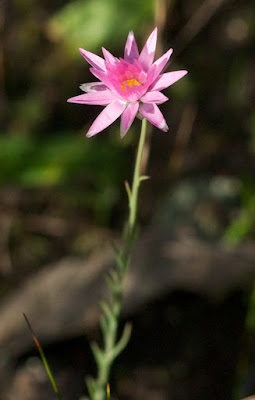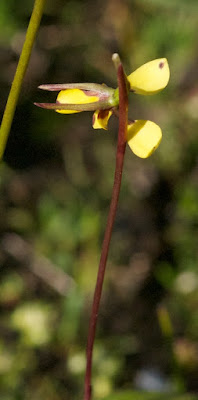By the late afternoon of September 17, 2013, our little group had been through three days of intense wildflower-watching among one of the richest floras in the world. My surely long-suffering readers should, by now, have an idea of how rich it is - based, if nothing else, on the fifteen(!) blog posts it has taken me to cover these few days alone. This, you may be relieved to hear, is the fifteenth and last account of our travels through the West Australian Kwongan country, before we turn back south to Perth and the country around and beyond it.
Our drive back to our coastal base in Jurien Bay took us back, again, through the farmland of the Wheatbelt, where we passed occasional flocks of Western Corellas (Cacatua pastinator) peering down at us from the eucalyptus trees that lined the road.
Just east of the village of Badgingarra we took a flower break at a roadside stop near the Hill River, close to (but not within) the extensive Badgingarra National Park.
The stop proved to be rich in wildflowers, many of them admittedly species we had seen before.
In places, Pink Everlastings (Schoenia cassiniana) carpeted the ground (as in the photo at the top of this post)...
...though our companions were more interested in the larger and showier Splendid Everlastings (Rhodanthe chlorocephala). As the first of these photos shows, their interest was shared by nectar-feeding flies.
Here, too, Common Cat's Paws (Anigozanthos humilis), smaller relatives of the larger and more famous kangaroo paws, but nonetheless (as I have noted in many earlier posts) beautiful and unusual flowers in their own right....
...grew amid clumps of yellow Conostylis flowers, members of the same family (Haemadoraceae).
We had seen, and photographed, milkmaids (Burchardia spp; Colchicaceae) many times already, but this is one of the few times I can hazard a specific identification: these appear to be Dwarf Burchardia (Burchardia multiflora).
Sundews of various sorts (Drosera spp) spread their insect-trapping leaves on the ground...
...or, like this Pink Rainbow (Drosera menziesii), clambered over the surrounding vegetation. Sundews bloom later than many of the other spring flowers of the southwest, and this was one of the few times I found one in flower.
As fgar as I was concerned, orchids were the main attraction. Cowslip Orchids (Caladenia flava), a species we had found in many places, were common here. This species is particularly variable. Some flowers are heavily marked with reddish blotches, while others, like these, are almost pure yellow. According to the bible on the subject, Noel Hoffman and Andrew Brown's Orchids of South-west Australia (3rd edition, 2011; University of Western Australia Press), these are clonal plants, growing in clumps of identical individuals, and the flowers in each clump may differ considerably in colour, size and shape.
Identifying donkey orchids (Diuris) can be tricky, but I believe this is a Bee Orchid (Diuris laxiflora), one of a complex of closely-related species that have been a headache for orchid taxonomists. It grows widely throughout the southwest, but according to Hoffman and Brown it favours soils that are saturated with water during the winter.
It was, though, this flower, a spider orchid, that became (at least for me) the most memorable single blossom of the entire trip. I can't say exactly why, but its combination of weirdness and beauty quite fascinated me - or perhaps I knew, even though we still had a few days left in our Western Australian trip, I was unlikely to see anything quite like it again.
It is, as far as I can tell, a Blushing Spider Orchid (Caladenia lorea), a highly localized species found only in a few areas. As lorea hybridizes with other spider orchids, however, I cannot be entirely certain. Like the much more widespread Bee Orchid, it prefers areas that are wet in winter.
Why does this flower look the way it does? What is the function of its long, spidery tassels, or of the palisade of spikes (technically known as a labellum fringe) that line its lip? As always with orchids, the answer depends on which pollinator the plant is trying to attract. Many spider orchids are pollinated by solitary male thynnine wasps, which apparently mistake the lip for a female and attempt to mate with it.
Although the lip does look vaguely insect-like, it is apparently the pheromone that lures the wasps in; the fringe probably act as as a guide drawing the insect to the heart of the flower. Newly-emerged males are more likely to visit - they haven't caught on to the orchid's tricks yet. As for the tassels - in some spider orchids the upper tassel forms a club that dissipates the phermones, but whether this particular orchid's spidery tassels waft wasp pheromones on the breeze I cannot say.
At length I tore myself away from the orchid, and we drove on north and west towards the coast...
...where we stopped at the Jurien Bay jetty to watch the sun sink into the Indian Ocean, and listen to the cries of the Silver Gulls (Chroiocephalus novaehollandiae)....
...until the skies grew dark, and a nearly full moon appeared in the sky, and we could reflect, as we packed for the drive south, on our adventure.































No comments:
Post a Comment